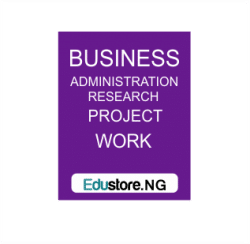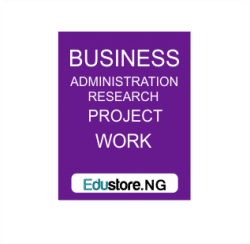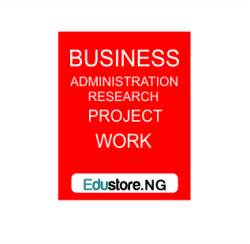A CRITICAL ANALYSIS OF THE USE OF ACCOUNTING RATIOS TO MEASURE FINANCIAL PERFORMANCE OF AN ORGANIZATION (A CASE STUDY OF UNILEVER FINACIAL STATEMENT FROM 2009 TO 2011)
CHAPTER ONE
- INTRODUCTION
Over the years, one major aim of most organizations in Ghana is to improve on their financial performances through effective and efficient accounting and finance practices. Financial performance of every organization in recent times have gained top priority, as most users of accounting and financial statement have developed indents in the financial position of the organization in question. Stakeholders of every organization need to know the financial performance of their organization, hence the need for managers to improve the financial position of the organization they manage. Assessing the financial position of an organization is the first step for organizations who want to improve their financial performances. After assessment, control measures are now established to correct deviations, and improve financial performance. The overview of the manufacturing industry in Ghana is explored including the various types of manufacturing organizations of which Unilever Company Limited is part. However, this research was undertaken to help assess the financial performance of manufacturing organizations for the periods, 2008, 2009 and 2010 using Unilever Company Limited as a case study.Â
1.1 BACKGROUND OF THE STUDY AND ORGANIZATIONAL PROFILE
  1.1.1 HISTORY OF THE GHANAIAN MANUFACTURING INDUSTRY
In 1957, after Ghana gained independence, the Nkrumah government launched an industrialization drive that increased manufacturing’s share of GDP from 10 percent in 1960 to 14 percent in 1970. This expansion resulted in the creation of a relatively wide range of industrial enterprises, the largest including the Volta Aluminum Company (Valco) smelter, saw mills and timber processing plants, cocoa processing plants, breweries, cement manufacturing, oil refining, textile manufacturing operations, and vehicle assembly plants. Many of these enterprises, however, survived only through protection. The overvalued cedi, shortages of hard-currency for raw materials and spare parts, and poor management in the state sector led to stagnation from 1970 to 1977 and then to a decline from 1977 to 1982.
Thereafter, the manufacturing sector never fully recovered, and performance remained weak into the 1990s. Underutilization of industrial capacity, which had been endemic since the 1960s, increased alarmingly in the 1970s, with average capacity utilization in large- and medium-scale factories falling to 21 percent in 1982. (CIA World Factbook, 2008)
Ghana’s record with industrialization projects since independence is exemplified by its experience with aluminum, the country’s most conspicuous effort to promote capital-intensive industry. This venture began in the mid-1960s with the construction of a 1,186-megawatt hydroelectric dam on the lower Volta River at Akosombo. Built with assistance from Britain, the United States, and the World Bank, the Akosombo Dam was the centerpiece of the Volta River Project (VRP), which the Nkrumah government envisioned as the key to developing an integrated aluminum industry based on the exploitation of Ghana’s sizable bauxite reserves and its hydroelectric potential. Foreign capital for the construction of an aluminum smelter in Tema was obtained from US-based Kaiser Aluminum, which acquired a 90 percent share in Valco, and from US-based Reynolds Aluminum, which held a 10 percent share. Valco became the principal consumer of VRP hydroelectricity, using 60 percent of VRP-generated power and producing up to 200,000 tons of aluminum annually during the 1970s. (CIA World Factbook, 2008)
Severe drought compounded the effects of unfavorable market conditions by reducing the electricity generating capacity of the Akosombo Dam and by forcing a temporary shutdown of the smelter from 1983 to 1985. Aluminum production was slow to recover in the wake of the shutdown. In the early 1990s, aluminum production and exports continued to be negligible.
Drastic currency devaluation after 1983 made it exceptionally expensive to purchase inputs and difficult to obtain bank credit, which hurt businessmen in the manufacturing sector. Furthermore, the ERP’s tight monetary policies created liquidity crises for manufacturers, while liberalization of trade meant that some enterprises could not compete with cheaper imports. These policies hurt industries beset by long recession, hyperinflation, outmoded equipment, weak demand, and requirements that they pay 100 percent advances for their own inputs. Local press reports have estimated the closure of at least 120 factories since 1988, mainly because of competitive imports. The garment, leather, electrical, electronics, and pharmaceuticals sectors have been particularly hard hit. In 1990, even the New Match Company, the only safety match company in the country, closed. (CIA World Factbook, 2008)
In 1986 the government established the Ghana Investment Center to assist in creating new enterprises. Between 1986 and 1990, the vast majority of projects approved—444 of 621—were in the manufacturing sector. Projected investment for the approved ventures was estimated at US$138 million in 1989 and at US$136 million in 1990. In the initial phase, timber was the leading sector, giving way in 1990 to chemicals. In 1991 the government established an office to deal with industrial distress in response to complaints that “unrestrained imports†of foreign products were undermining local enterprises. The 1992 budget included assistance for local industrialists; ¢2 billion was set aside as financial support for “deserving enterprises.â€
The dominant trends in manufacturing, nonetheless, were the involvement of foreign capital and the initiation of joint ventures. Significant new enterprises included a US$8 million Taiwanese-owned factory, capable of turning out ten tons of iron and steel products per hour, which began trials at Tema in 1989. Although approximately 500 projects had been approved since the investment code came into force in 1985, almost half had still not been launched by the end of 1989. Between 90 and 95 percent of the approved projects were joint ventures between foreign and local partners, 80 percent of which were in the wood industry. (CIA World Factbook,
1.1.2 Company Profile
Unilever Ghana Limited was established in Ghana between 1928-1931 as the United African Company (UAC) out of two companies, the lever Brothers’ company and the African and Eastern Trade Corporation. The Lever factory was built in 1963. The UAC was absorbed into its parent Company Unilever from the United Kingdom to form Unilever Ghana Limited in 1992. It had already been operating as a trading company but later shifted to manufacturing. Currently, the company’s business in Ghana comprises the manufacturing and distribution of food products like cooking oil, spices and iodised salts, home care products like soaps and detergents and personal care products like body, hair and oral care products. The company has eleven departments which includes; The customer Development department, Human Resource department, Brand Building department , Legal department, Supply Chain department, Production department, Finance department, sales routine department ,Transport department, Quality department and Information Technology department. The company has its headquarters at Tema and has 900 employees across the country.
Unilever Ghana Limited is a public company domiciled in Ghana. The company’s country of incorporation is Ghana. The address of the company’s registered office is Tema Factory, P. O. Box 721, Tema, Ghana. The consolidated financial statements of the company as at the year ended 31 December 2008 comprise the company and its subsidiaries (together referred to as the “Group”). The Group primarily is involved in the manufacture of consumer products, the growing of oil palm and the processing of palm fruits to produce palm oil and palm kernel. The company is listed on the Ghana Stock Exchange. The ultimate parent company is Unilever PLC, a company incorporated in England. Other related parties,
Unilever Overseas Holdings Limited, UAC International Limited and CWA Holdings Limited, Companies wholly owned by Unilever PLC has significant shareholdings in Unilever Ghana Limited. In view of the fact that Unilever Ghana Limited has the power to exercise control over the operating and financial policies of Twifo Oil Palm Plantations (TOPP) Limited, and in accordance with International Financial Reporting Standards, TOPP has been designated as a subsidiary. In October 2003, Unilever Ghana Limited acquired 58.45% shares in Benso Oil Palm Plantation Limited from Unilever Overseas Holdings/CWA Holding, a company based in the United Kingdom.
1.2 STATEMENT OF THE PROBLEM
The manufacturing industry today is an integral part of the Ghanaian economy. The manufacturing industry has gone through some transitions to its current state. The industry over a number of decades now has experienced great decline and as a result most of the organizations have closed down due to poor performances. In this light, successive governments have made great stride to improve this industry by way of reviving some of the dead organizations.
Moreover, the continued growth of an institution may depend on its ability to generate adequate resources from its day to day operations. Financial performance measurement or assessment is therefore imperative in assessing the growth and progress of a business. Assessing the financial position of a company in a likewise manner requires examination of its past and current performance in order to predict its future prospects. By using financial performance measures, a company’s performance can be linked more closely to shareholder’s value and wealth. Attention can, thus, be directed to ways in which companies can create more value for shareholders. Therefore, this study seeks to adopt ratio analysis as a key financial performance appraisal method to examine, evaluate and interpret the growth trend of Unilever Company Limited.
- RESEARCH OBJECTIVES
The purpose of the study is to assess the financial performance of manufacturing organizations for the period, 2008, 2009 and 2010 using Unilever Company Limited as a case study. The objectives of the study include:
- To measure the liquidity position of Unilever Company Limited.
- To find out the profitability trend of the organization given its level of investment and turnover.
- To find out the level of gearing and investment ratios of the organization.
- To assess the performance measurement policy within Unilever Company Limited.
- RESEARCH QUESTIONS
1. What is the liquidity position of Unilever Company Limited?
2. Given their level of investment turnover, what is the profitability trend of the organization?
3. What is the ratio between the levels of gearing and investment of the organization?
4. What performance measurement policy is adapted within the organization?
1.5 SIGNIFICANCE OF THE STUDY
This study gives insight into the various ways or techniques that will help improve organizations performance and how the financial performance of organizations in Ghana can be properly assessed. The study will also go a long way in showing the various accounting techniques that managers can adopt in measuring financial performances, and its implications on the financial position of organizations.
The findings and recommendations of the researcher will help in building a strong and better accounting practices that will help in the assessment of organizations performance in Ghana, if taken seriously by government and the general public. It may serve as a reference to other researchers who may want to research into the field.
1.6 SCOPE OF THE STUDY
The overall scope of the study is to assess the financial performances of Unilever Company Limited for the periods 2008, 2009 and 2010. Unilever Company Limited was chosen because it is near to the researcher and gathering of information also becomes very easy. The above periods were also chosen because; the researcher wants to assess the more recent financial performance of the company under study. With the assessment of the financial performance, the researcher will adopt the concept of ratio analysis tools and techniques. The scope in terms of location can be found in the Eastern Religion, Koforidua. This region was selected because of proximity to the researcher.
1.7 LIMITATIONS OF THE STUDY
Notwithstanding the concern for efficient, effective and dependable findings, there were few limitations encountered in the course of carrying out the study. Among these include:
1)Â Limited funds available to undertake the study.
2)Attitude of Respondents: there was a poor response from respondents to interviews which brings difficulty in compiling and analyzing available data.
3)Availability of Data: There was also the problem of getting data from the selected organizations. That is, there was delay in getting the data needed from the organizations .or not getting it at all.
1.8 ORGANIZATION OF THE STUDY.
This research paper is organized into chapters, with the chapters being organized as below:
Chapter one – this chapter includes the general introduction, background information about the study, statement of the problem, objectives of the study, research questions, scope of the study, significance of the study, and the limitation of the study.
Chapter Two – this chapter reviews the related literature on the topic-Assessing the financial performance of Unilever Company Limited for the periods 2008, 2009 and 2010. This chapter considers both the empirical and theoretical literature available on the subject matter.
Chapter Three – this chapter deals with methodology of the research. That is the various methods that the researcher adopted in carrying out the research. This chapter includes the study site, research design, data collection methods, data analysis and limitations.
Chapter Four – this chapter is concerned with the discussion of Data, analysis of data and the interpretation of the data collected. That is, how the data was processed, presented, arranged etc. to bring out the meaning in them so to help achieve the objectives of the study. The chapter is made of absolute figures, charts, tables etc in analyzing the data collected.
Chapter Five – Summary of findings, Conclusion and Recommendations. This chapter deals with presentation of findings, making conclusions from the findings of the study and its implication. It considers recommendations and suggestions based on the findings of the study.
DOWNLOAD COMPLETE WORK- For Reference Only: Materials are for research, citation, and idea generation purposes and not for submission as your original final year project work.
- Avoid Plagiarism: Do not copy or submit this content as your own project. Doing so may result in academic consequences.
- Use as a Framework: This complete project research material should guide the development of your own final year project work.
- Academic Access: This platform is designed to reduce the stress of visiting school libraries by providing easy access to research materials.
- Institutional Support: Tertiary institutions encourage the review of previous academic works such as journals and theses.
- Open Education: The site is maintained through paid subscriptions to continue offering open access educational resources.






